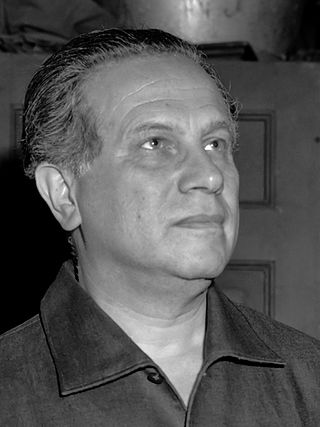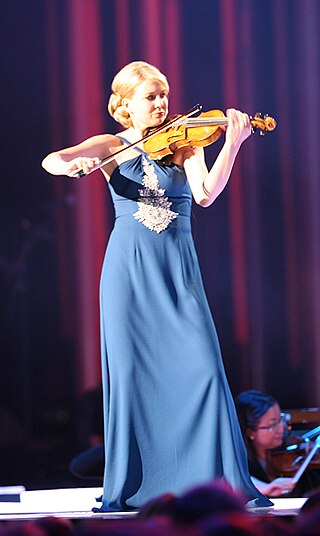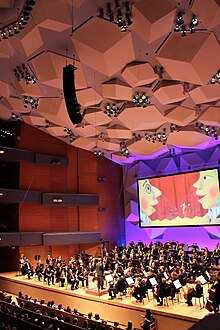
Antal Doráti was a Hungarian-born conductor and composer who became a naturalized American citizen in 1943.

Jukka-Pekka Saraste is a Finnish conductor and violinist.

Osmo Antero Vänskä is a Finnish conductor, clarinetist, and composer.

The Violin Concerto in D minor, Op. 47 of Jean Sibelius, originally composed in 1904 and revised in 1905, is the only concerto by Sibelius. It is symphonic in scope and included an extended cadenza for the soloist which takes on the role of the development section in the first movement.

The Royal Scottish National Orchestra (RSNO) is a Scottish orchestra, based in Glasgow. It is one of the five national performing arts companies of Scotland. Throughout its history, the Orchestra has played an essential part in Scotland’s musical life, including performing at the opening ceremony of the Scottish Parliament building in 2004.

Leonidas Kavakos is a Greek violinist and conductor. As a violinist, he has won prizes at several international violin competitions, including the Sibelius, Paganini, Naumburg, and Indianapolis competitions. He is an Onassis Foundation scholar. He has also recorded for record labels such as Sony/BMG and BIS. As a conductor, he was an artistic director of the Camerata Salzburg and has been a guest conductor of the London Symphony Orchestra and Boston Symphony Orchestra.

Kullervo, Op. 7, is a five-movement symphonic work for soprano, baritone, male choir, and orchestra written from 1891–1892 by the Finnish composer Jean Sibelius. Movements I, II, and IV are instrumental, whereas III and V feature sung text from Runos XXXV–VI of the Kalevala, Finland's national epic. The piece tells the story of the tragic hero Kullervo, with each movement depicting an episode from his ill-fated life: first, an introduction that establishes the psychology of the titular character; second, a haunting "lullaby with variations" that portrays his unhappy childhood; third, a dramatic dialogue between soloists and chorus in which the hero unknowingly seduces his long-lost sister; fourth, a lively scherzo in which Kullervo seeks redemption on the battlefield; and fifth, a funereal choral finale in which he returns to the spot of his incestuous crime and, guilt-ridden, takes his life by falling on his sword.
Minnesota Youth Symphonies, commonly referred to as MYS, was founded in 1972 by Ralph Winkler. The program has five orchestras composed of students from elementary level through high school, with participation's based on an annual audition. All levels of MYS perform at Orchestra Hall in Minneapolis, as well as other locations, and hosts workshops and classes.

Sinfóníuhljómsveit Íslands (ISO) is an Icelandic orchestra based in Reykjavík, Iceland. Its primary concert venue is the Harpa Concert Hall. The Iceland Symphony is an autonomous public institution under the auspices of the Icelandic Ministry of Education. Iceland Symphony Orchestra made its home in Háskólabíó from 1961 to 2011, but moved into the new 1800-seat Harpa Concert Hall in spring 2011. The orchestra gives approximately sixty concerts each season. Per a 1982 law, the Iceland Symphony's primary financial sources are the Icelandic treasury (82%) and the City of Reykjavik (18%).

The Seoul Philharmonic Orchestra (SPO) is a South Korean orchestra based in Seoul. Founded in 1948, it is one of the oldest orchestras in South Korea. Its first foreign tour came on a 1965 trip to Japan, followed by performances in Southeast Asia in 1977, the United States in 1982, 1986, and 1996, a 1988 tour of Europe before the Seoul Olympics that year, and a 1997 performance in Beijing. The Philharmonic is an incorporated foundation since 2005.
Sharon Bezaly is a flutist.
The Lahti Symphony Orchestra is a Finnish orchestra, based in the city of Lahti. The orchestra is resident at the Sibelius Hall. The orchestra was founded in 1910, and placed under the control of the Lahti municipality in 1949.

Lilli Katriina Paasikivi-Ilves is the artistic director of the Finnish National Opera since 2013 and a mezzo-soprano.

Elina Vähälä is a Finnish classical violinist.

Belshazzar's Feast, JS 48, is incidental music by Jean Sibelius to a play of the same name by the journalist, poet and playwright Hjalmar Fredrik Eugen Procopé (1868−1927).
Richard K. Davis is an American businessman. Since January 2, 2019 Davis has served as the chief executive officer of Make-A-Wish America, having previously served as Executive Chairman and President of U.S. Bancorp.

Cassazione, Op. 6, is an orchestral composition by Jean Sibelius, composed in 1904 for the programme that introduced his Violin Concerto. Its title refers to the cassation, a genre similar to the serenade, which was popular in the late 18th century. Sibelius structured the work in five "episodes". Although his opus numbers were already in the forties, he assigned the unused number Op. 6 to this work, implying an earlier composition date.
Towards the Horizon is the second cello concerto by the Finnish composer Einojuhani Rautavaara. The work was commissioned by the Minnesota Orchestra under the direction of Osmo Vänskä. It was first performed by the cellist Arek Tesarczyk and the Minnesota Orchestra conducted by Osmo Vänskä in Orchestra Hall, Minneapolis, on September 30, 2010. The piece is dedicated to the cellist Truls Mørk, who was originally scheduled to perform the world premiere, but had to drop due to health concerns.

The Finnish composer Jean Sibelius (1865–1957) was one of the most important symphonists of the early twentieth century: his seven symphonies, written between 1899 and 1924, are the core of his oeuvre and stalwarts of the standard concert repertoire. Many of classical music's conductor–orchestra partnerships have recorded the complete set, colloquially known as the "Sibelius cycle". Specifically, the standard cycle includes:














